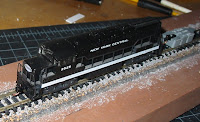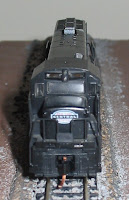Staging Control Panel
 A while ago I constructed a staging yard on my old layout base. They sat under my bed for a while because I was waiting on switches to arrive so that I could control which tracks got power. The switches arrived, and the staging yard still sat under my bed. The staging yard saw its first trains tonight.
A while ago I constructed a staging yard on my old layout base. They sat under my bed for a while because I was waiting on switches to arrive so that I could control which tracks got power. The switches arrived, and the staging yard still sat under my bed. The staging yard saw its first trains tonight.Earlier today I finally got around to installing the control panel and wiring up the staging yard. The above picture shows the staging yard hooked up to my layout, and taking up most of my bedroom.
 The control panel is pictured above. It took a little improvising: the switches are held onto the styrene control panel with twisted wire due my lack of appropriatly sized screws. The holes above the switches are for LEDs to indicate which track has power. That part of the project is still on hold. I need to get properly sized resistors as well as figure out how the LEDs will get power. There are hookups between the old and new layout, the track power is transmitted via the rails.
The control panel is pictured above. It took a little improvising: the switches are held onto the styrene control panel with twisted wire due my lack of appropriatly sized screws. The holes above the switches are for LEDs to indicate which track has power. That part of the project is still on hold. I need to get properly sized resistors as well as figure out how the LEDs will get power. There are hookups between the old and new layout, the track power is transmitted via the rails.



